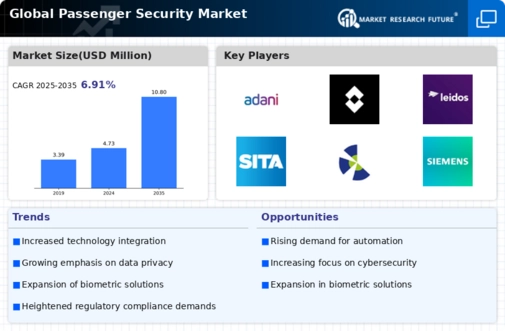Market Share
Passenger Security Market Share Analysis
“The Passenger Security market is currently undergoing transformations that are indicators of the changing dynamics of airport security, public transportation safety and passenger experience; a remarkable trend is the increasing integration of sophisticated screening technologies at airports and transportation hubs. The use of advanced body scanners, state-of-the-art x-ray machines, biometric identification technology, help to improve security as well as the efficiency of passenger screening systems. This trend reflects the industry’s commitment to innovative solutions that can reconcile strict security protocols with seamless and speedy passenger flow.
Another key trend is the increased adoption of biometrics for verifying passengers’ identities. Biometric technologies like facial recognition, fingerprint scanning and iris recognition are increasingly being used to enhance security and streamline passenger journeys from check-in to boarding, airports and transport authorities are using biometrics to create an effortless yet secure journey for travelers. It shows that amid concerns about privacy airlines seek to combine more secure measures on their way forward so they will not hinder customer rights with those laws that protect privacy in this new era of digital transformation.
Additionally, the Passenger Security market has witnessed an upsurge in artificial intelligence (AI) and machine learning (ML) adoption in its security systems. AI video analytics, behavior detection algorithms and predictive analytics help identify potential threats faster than ever before by using real-time monitoring capabilities.This leads to proactive approaches by which security issues can be addressed ahead before becoming major ones resulting into safeguarding both passengers' safety as well as the infrastructure.
The market also experiences increased focus on cyber-security within passenger security systems; with aviation and transportation increasingly employing digital technologies, they become prone to cyber threats. This trend includes deploying robust cybersecurity controls that safeguard critical details on passengers, communication networks or even control systems. This cybersecurity emphasis addresses the evolving threat landscape in the digital age protecting sensitive data while securing integrity within passenger security systems.
Besides this there is a push for integrated security solutions covering various aspects of passenger safety; integrating video surveillance with access control, biometrics and cyber security features creates one platform. This integration of security solutions simplifies the security operations, supports real-time monitoring and response as well as enhances overall efficiency of passenger safety measures. It is a way of looking at passengers’ safety holistically by recognizing how various security threats are interconnected within the transport sector.
Also, the Passenger Security market is witnessing trends in passenger screening technologies that give priority to privacy concerns; advanced screening technologies maintaining a balance between effective threat detection and privacy for passengers are on the rise. By addressing concerns about invasive security controls, this trend makes sure that passengers’ rights conform to statutory regulations governing their privacy.Thus, there has been an emphasis on preserving human dignity and privacy during such processes.
Moreover, there is a growing tendency towards touchless or contactless technologies in passenger security procedures; COVID-19 pandemic has underscored this change by accelerating adoption of touchless solutions such as contactless check-in, biometric boarding passes or even no-touching airport security equipment. In addition to addressing health and hygiene considerations, these developments also result into faster more convenient trips for travelers hence consistent with new demands from tourists in a post-pandemic era.”











Leave a Comment